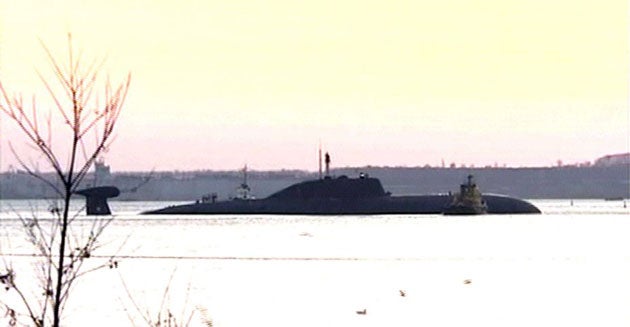Russian navy investigates worst tragedy since 'Kursk'

Investigators are trying to discover why 20 people died of suffocation on a Russian nuclear submarine after a fire extinguishing system released a poisonous gas into part of the vessel.
Three submariners and 17 civilian workers suffocated and 21 others were injured in the Akula II attack class submarine, which was on trials in the Japanese Sea on Saturday evening.
In the worst incident for the Russian navy since the sinking of the Kursk submarine in 2000, Freon gas, which puts out fires by removing oxygen from the air, was released when the fire extinguishing system unexpectedly switched on in the nose of the vessel.
"In small concentrations it can cause drunkenness, in large doses it is lethal," said Gennady Illarionov, from the Institute of Naval Technological Problems.
Distraught relatives gathered in the port of Bolshoi Kamenm, near Vladivostok, in the far east of Russia, from where the vessel had sailed. One woman told television reporters that she could not find any information on her missing relative.
The tragedy comes as an embarrassment for the Russian government as it has vowed to rebuild the country's once mighty military force and has attempted to extend the navy's reach.
The accident also revives painful memories of the Kursk disaster in which 118 submariners died after torpedo explosions on board sunk the vessel in the Barents Sea in August 2000. The disaster took place just a few months into President Vladimir Putin's first term. At the time he was criticiced for not making any public comments and for failing to seek foreign assistance with the rescue.
His successor, President Dimitry Medvedev, asked the defence minister to launch an investigation, keep him constantly informed and help the families of the victims, the Kremlin said, but did not make any public comments on the tragedy.
The submarine itself, part of the Russian Pacific fleet, was not damaged in the accident and there was no radiation leak a navy spokesman said.
"I declare with full responsibility that the reactor compartment on the nuclear-powered submarine is working normally and the radiation background is normal," Captain Igor Dygalo told Itar-Tass news agency.
Russian authorities have yet to name the submarine class and specify where the accident took place, but one military source said that it was likely the Nerpa, a Shark II attack vehicle.
The submarine was to be leased to India next year, where it was to be renamed the Chakram for 10 years, wrote The Sea Bulletin.
The Russian Prosecutor General's Office launched an investigation into the accident, which will focus on what activated the firefighting system and possible violations of operating rules.
Experts suggested that human error and a lack of funding following the fall of the Soviet Union could have caused the accident.
Seventeen of those killed were civilians believed to be shipyard workers. There were 208 people on board the submarine, only 81 of whom were servicemen.
Crew members carry special breathing apparatus with them at all times as protection from the gas if the fire extinguishing system goes off. They are also trained to use the complicated apparatus.
"It can't be excluded that some of the civilians did not have PDU [breathing apparatus] and if they did, they did not know how to use them," said Mr Illarionov.
Despite the rhetoric about rebuilding military might, Russia's armed forces remain hampered by corruption, incompetence and a loss of crucial skills. In Soviet times, three to five nuclear submarines were built every year but now it is one every five years.
Join our commenting forum
Join thought-provoking conversations, follow other Independent readers and see their replies
Comments